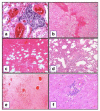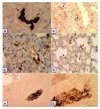Assessment of Risk Factors in Synanthropic and Wild Rodents Infected by Pathogenic Leptospira spp. Captured in Southern Chile
- PMID: 33212843
- PMCID: PMC7697743
- DOI: 10.3390/ani10112133
Assessment of Risk Factors in Synanthropic and Wild Rodents Infected by Pathogenic Leptospira spp. Captured in Southern Chile
Abstract
Leptospirosis is caused by pathogenic Leptospira, and synanthropic and wildlife species of rodents are an important source of infection; however, much of the information about infection progression was obtained from murine models. The aim of this study was to assess infection status and risk factors associated with pathogenic Leptospira in synanthropic and wild rodent species and describe histopathological lesions in several organs from naturally infected animals. In a cross-sectional study, 121 rodents from three synanthropic species and two wild species were trapped in dairy farms in Southern Chile. Liver, heart, kidney, and lungs from trapped animals were fixed in formalin and stained with hematoxylin-eosin. Tissues with lesions consistent with Leptospira infection were tested by immunohistochemistry (IHC) and real-time polymerase chain reaction (qPCR) using the LipL32 antigen. Risk factors were assessed by a conditional mixed-logistic regression model. More than half (56.7%) of the negative reactors to the microscopic agglutination test were identified as infected either by IHC/qPCR. A lower risk of infection compared to the rest of the seasons was found in the fall, and the synanthropic species have a lower risk of infection in comparison with the wildlife species. IHC and qPCR contributed to the identification of pathogenic Leptospira in related histological lesions and 50% more infections than serology.
Keywords: infection status; leptospirosis; rodents.
Conflict of interest statement
The authors declare no conflict of interest. The funders had no role in the design of the study; in the collection, analyses, or interpretation of data; in the writing of the manuscript, or in the decision to publish the results.
Figures



Similar articles
-
First histopathological study in kidneys of rodents naturally infected with Leptospira pathogenic species from Yucatan, Mexico.Asian Pac J Trop Med. 2016 Feb;9(2):145-7. doi: 10.1016/j.apjtm.2016.01.018. Epub 2016 Jan 11. Asian Pac J Trop Med. 2016. PMID: 26919944
-
New insights on the infection of pathogenic Leptospira species in American mink (Neovison vison) in southern Chile.Trop Anim Health Prod. 2020 Nov 16;53(1):2. doi: 10.1007/s11250-020-02469-2. Trop Anim Health Prod. 2020. PMID: 33196883
-
Molecular detection of pathogenic Leptospira in synanthropic and wild rodents captured in Yucatán, México.Biomedica. 2018 Aug 1;38(0):51-58. doi: 10.7705/biomedica.v38i3.3938. Biomedica. 2018. PMID: 30184363
-
Molecular Detection of Leptospira spp. in Rodents Trapped in the Mozambique Island City, Nampula Province, Mozambique.EC Microbiol. 2018 Dec;14(12):813-821. Epub 2018 Nov 27. EC Microbiol. 2018. PMID: 31681910 Free PMC article.
-
[Leptospira infections in cats].Tierarztl Prax Ausg K Kleintiere Heimtiere. 2017 Apr 19;45(2):103-108. doi: 10.15654/TPK-160912. Epub 2017 Mar 22. Tierarztl Prax Ausg K Kleintiere Heimtiere. 2017. PMID: 28327780 Review. German.
Cited by
-
Bovine leptospirosis: effects on reproduction and an approach to research in Colombia.Trop Anim Health Prod. 2022 Aug 9;54(5):251. doi: 10.1007/s11250-022-03235-2. Trop Anim Health Prod. 2022. PMID: 35943610 Free PMC article. Review.
-
Identifying the Drivers Related to Animal Reservoirs, Environment, and Socio-Demography of Human Leptospirosis in Different Community Types of Southern Chile: An Application of Machine Learning Algorithm in One Health Perspective.Pathogens. 2024 Aug 14;13(8):687. doi: 10.3390/pathogens13080687. Pathogens. 2024. PMID: 39204287 Free PMC article.
-
Activity patterns and interactions of rodents in an assemblage composed by native species and the introduced black rat: implications for pathogen transmission.BMC Zool. 2022;7(1):48. doi: 10.1186/s40850-022-00152-7. Epub 2022 Aug 26. BMC Zool. 2022. PMID: 36042784 Free PMC article.
-
Pathogenic Leptospira spp. Seroprevalence and Herd-Level Risk Factors Associated with Chilean Dairy Cattle.Animals (Basel). 2021 Nov 4;11(11):3148. doi: 10.3390/ani11113148. Animals (Basel). 2021. PMID: 34827880 Free PMC article.
-
Knowledge, risk perceptions and practices regarding rodents and their associated pathogens: environmental consultants in Chile.One Health Outlook. 2024 Dec 1;6(1):27. doi: 10.1186/s42522-024-00123-7. One Health Outlook. 2024. PMID: 39616377 Free PMC article.
References
-
- Gouveia E.L., Metcalfe J., De Carvalho A.L.F., Aires T.S., Villasboas-Bisneto J.C., Queirroz A., Santos A.C., Salgado K., Reis M.G., Ko A.I. Leptospirosis-associated Severe Pulmonary Hemorrhagic Syndrome, Salvador, Brazil. Emerg. Infect. Dis. 2008;14:505–508. doi: 10.3201/eid1403.071064. - DOI - PMC - PubMed
Grants and funding
LinkOut - more resources
Full Text Sources
Miscellaneous

